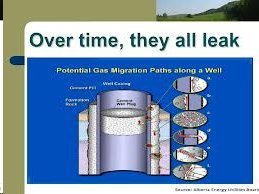New concerns arise over fracking’s safety for society
From an Article by Bruce Kennedy, CBS / Moneywatch, July 2, 2014
The ongoing controversy over the method for removing oil and gas from unconventional, hard-to-reach underground deposits that’s known as hydraulic fracturing, or “fracking,” has some new data to chew on.
It seems a large percentage of oil and gas wells tapping the Marcellus Shale region of Pennsylvania are leaking methane gas, either into the air or into underground sources of drinking water. That’s the finding of an analysis conducted by a Cornell University-led research team and published this week in the Proceedings of the National Academy of Sciences.
The team looked at compliance reports for more than 41,000 conventional and unconventional oil and gas wells in Pennsylvania. It determined that unconventional gas wells in northeastern Pennsylvania had a nearly three-fold higher risk of leaking, compared to conventional wells in the same region. One possible factor for this so-called “methane migration,” according to the study, could be “compromised structural integrity” in the casings and cement used in the unconventional oil and gas wells.
“These results, particularly in light of numerous contamination complaints and explosions nationally in areas with high concentrations of unconventional oil and gas development and the increased awareness of the role of methane in anthropogenic [man-made] climate change, should be cause for concern,” it concluded. “In a typical well, hundreds of bags of cement are mixed and injected,” Anthony Ingraffea, one of the study’s lead authors and a Cornell professor of civil and environmental engineering, told the University’s Cornell Chronicle news site. ”If the water-to-cement mixture ratio isn’t right, you have problems,” he said. “With too much water, the cement shrinks. With too little water, the mixture dries too fast.”
The energy industry has fired back against the new report. ”This paper is a work of deception that massively exaggerates the risks of domestic oil and natural gas production,” Katie Brown, spokesperson for Energy in Depth — a program of the Independent Petroleum Association of America (IPAA) — said in a statement. “The lead author claims to be an objective researcher,” she continued, “but he’s really an outspoken opponent of drilling who works with fringe environmental groups and celebrity anti-energy activists like performance artist Yoko Ono and Hollywood actor Mark Ruffalo.”
Fracking has helped bring about an historic oil and gas production boom in the U.S., creating energy supplies that are moving the U.S. closer to energy independence. On Tuesday, the U.S. Energy Information Administration (EIA) reported that American crude oil production for April was 8.4 million barrels per day. Texas and North Dakota, two states where fracking is in wide use, accounted for nearly half the total.
However, opponents have been pointing to fracking’s potential health dangers, such as possible wide-scale pollution of essential drinking water supplies, as reasons to limit or even completely ban the process.
But Mark Zoback, a Stanford University geophysicist, member of the National Academy of Engineering’s Deepwater Horizon investigation committee and a fracking expert, says this technology has a place, as long as the states and federal government set up rigorous standards to oversee its use and protect both the public and the environment. “The oil and gas industry is a large-scale industrial process, [like] food preparation, aviation, transportation, chemical plants,” Zoback recently told the Los Angeles Times. “We live in a highly technological and complex society,” he said, “and the only way we can survive is through the marriage between technology and regulation.
Also: “Scientists in Ohio link fracking to earthquakes”
Also: “Wisconsin debates fracking as sand mining for drilling booms”

